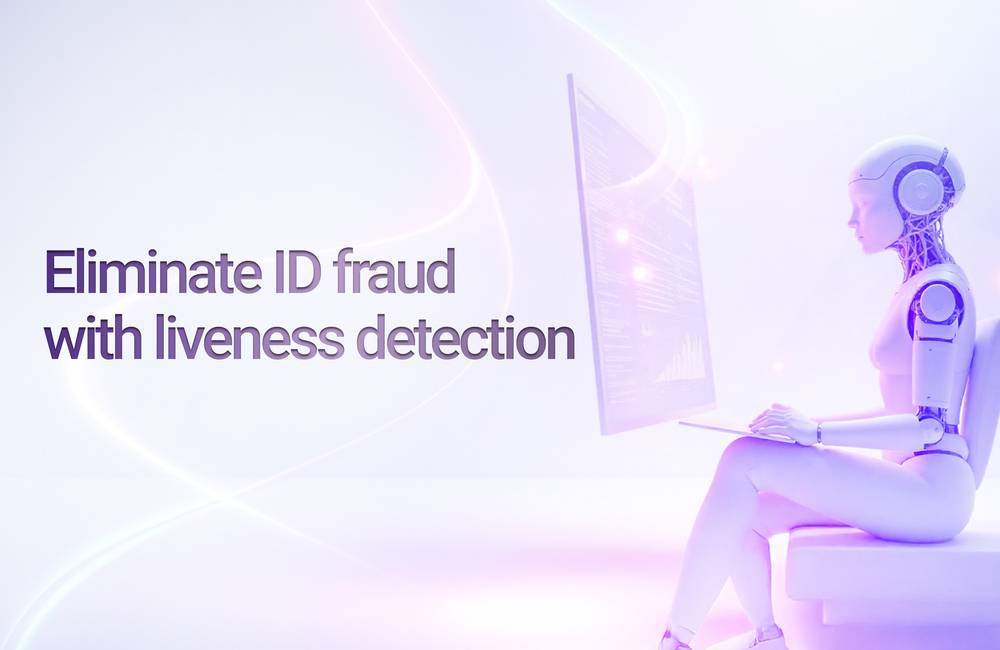How security leaders can eliminate ID fraud with liveness detection Written on

TL;DR
-
$47 billion in identity fraud losses occurred in 2024 alone, with traditional authentication methods failing to protect against sophisticated attacks.
-
IT decision makers and security professionals face mounting pressure to implement fraud-resistant authentication while maintaining user experience.
-
Biometric authentication with liveness detection can reduce presentation attack success rates to 0% when properly implemented, according to ISO 30107-3 certified solutions.
-
Implementation typically achieves ROI within 12-18 months through reduced fraud losses and operational efficiency gains.
-
Regulatory compliance requirements make advanced biometric verification essential by mid-2025.
The authentication landscape has reached a critical inflection point. While organizations rush to digitize operations and customer experiences, they're inadvertently creating massive security vulnerabilities that criminals exploit with devastating efficiency. The numbers tell a stark story that no security leader can afford to ignore.
In this blog, we will explore the steps organizations must take to address these challenges and protect their digital ecosystems.
The $47 billion authentication statistics that matter
The scope of identity-related attacks has exploded across multiple vectors. Account takeover fraud alone resulted in $15.6 billion in losses in 2024, up from $12.7 billion in 2023. New account fraud reached $12 billion, while synthetic identity fraud continues to grow as criminals leverage AI-generated personas that traditional verification methods cannot detect.
Even more concerning, 83% of organizations experienced at least one account takeover instance in the past year, yet only 43% of victims were notified by companies that their information had been compromised. This disconnect between attack frequency and detection capabilities highlights the fundamental inadequacy of password-based and traditional multi-factor authentication systems.
The statistics become even more troubling when examining the human element. An annual analysis of recaptured darknet data shows a 70% password reuse rate for users exposed in two or more breaches, creating cascading vulnerabilities that criminals exploit systematically. Meanwhile, credential theft attacks from phishing campaigns rose 703% in the second half of 2024, demonstrating how traditional authentication methods fail against evolving social engineering tactics.
Authentication failure's impact on security leaders: the need for enterprise fraud prevention
For IT decision makers and security professionals, these trends create an impossible situation. Traditional authentication methods like passwords and SMS-based two-factor authentication have become liability generators rather than security tools. Yet the pressure to maintain seamless user experiences while implementing stronger security measures continues to intensify.
The regulatory environment compounds these challenges. Financial institutions face enhanced AML requirements by mid-2025, with severe sanctions for serious breaches. Healthcare organizations must navigate HIPAA compliance while protecting patient data from increasingly sophisticated attacks. Even non-financial entities face growing scrutiny as data privacy regulations expand globally.
Why are traditional authentication methods inadequate for modern enterprise security?
Password-based authentication systems suffer from fundamental design flaws that no amount of complexity requirements can overcome. Users create weak, reusable passwords that criminals easily compromise through data breaches, social engineering, or brute force attacks. Even when combined with SMS-based two-factor authentication, these systems remain vulnerable to SIM swapping, phishing, and man-in-the-middle attacks.
Knowledge-based authentication faces similar limitations. Security questions rely on information that's often publicly available or easily guessed, while the answers themselves become compromised in data breaches. Device-based authentication provides some improvement but fails when devices are lost, stolen, or compromised.
The core problem with all traditional methods is their reliance on shared secrets or transferable tokens. Passwords can be guessed or stolen. SMS codes can be intercepted. Security questions can be researched. Hardware tokens can be duplicated or stolen. These methods authenticate something the user knows or has, not who they actually are.
Biometric authentication with liveness detection: The future of secure identity verification
The biometric authentication market has reached a transformative moment, driven by technological breakthroughs that finally make truly secure, user-friendly authentication possible. The market is forecast to get stronger over the coming three years with revenue forecasts exceeding $252 million (USD) annually by 2027 — a CAGR of 36 percent over the three-year period. This explosive growth isn't just market enthusiasm: it represents a fundamental shift toward authentication methods that verify human identity directly rather than relying on intermediary secrets or tokens.
Modern biometric authentication systems have evolved far beyond simple fingerprint scanners or basic facial recognition. Today's advanced solutions incorporate multiple layers of security, including presentation attack detection, continuous authentication, and behavioral biometrics. The integration of artificial intelligence and machine learning has dramatically improved accuracy while reducing false positives and negatives that historically plagued biometric systems.
How advanced biometric authentication works
Contemporary biometric authentication systems operate through sophisticated multi-stage processes that verify identity with unprecedented accuracy and security. The process begins with biometric capture using high-resolution sensors that record unique physiological characteristics like facial geometry, fingerprint minutiae, or iris patterns. Advanced algorithms then extract distinctive features from these biometric samples, creating mathematical templates that represent the user's unique identity.
The critical innovation in modern systems is the integration of liveness detection technology, which ensures that biometric samples come from living subjects rather than spoofed presentations. Active liveness detection challenges users to perform specific actions like blinking, smiling, or moving their head, while passive liveness detection analyzes subtle physiological characteristics like skin texture, micro-movements, and optical properties without requiring user interaction.
Benefits beyond fraud prevention
While fraud prevention represents the most obvious advantage of biometric authentication, the technology delivers comprehensive benefits that transform organizational security posture and operational efficiency. User experience improvements rank among the most significant advantages, as biometric authentication eliminates password-related friction that frustrates users and generates support tickets.
Organizations implementing biometric authentication typically see dramatic reductions in help desk calls related to password resets and account lockouts. Users can authenticate instantly using their biological characteristics, eliminating the need to remember complex passwords or carry additional authentication devices. This convenience translates directly into productivity gains and user satisfaction improvements.
Scalability represents another crucial advantage. Once implemented, biometric authentication systems can accommodate unlimited users without degrading performance or security. Organizations can onboard new employees or customers instantly without distributing passwords, tokens, or other authentication materials. This scalability proves particularly valuable for organizations experiencing rapid growth or seasonal workforce fluctuations.
Real-world applications across industries
Financial services organizations have emerged as early adopters of advanced biometric authentication, driven by regulatory requirements and the high cost of fraud. Leading banks use facial recognition with liveness detection for mobile banking authentication, reducing account takeover attempts while improving customer experience.
In iGaming, facial recognition is employed to verify identities, preventing fraud, and ensuring compliance with age and location-based restrictions. These technologies not only protect operators from illegal activities but also offer players a smoother, more secure gaming experience.
In the hospitality industry, biometrics are revolutionizing guest check-ins and access management. Hotels use facial recognition for seamless check-ins, reducing wait times and enhancing overall guest satisfaction. Mobile apps integrated with biometric authentication enable personalized services, ensuring security while creating a more convenient and efficient experience for guests.
Mobility services, including ride-sharing and car rentals, are adopting biometric authentication to improve security and user convenience. Drivers and passengers can quickly verify their identities using facial recognition, reducing the risk of fraudulent rides and ensuring both parties feel safe throughout the journey.
These real-world applications across industries highlight the versatility and effectiveness of biometric authentication, not only in improving security but also in delivering a better, more efficient user experience.
Implementation strategy for security leaders
Successfully implementing biometric authentication with liveness detection requires careful planning that addresses technical, regulatory, and user experience considerations. Security leaders must develop comprehensive strategies that ensure seamless integration with existing systems while maintaining compliance with applicable regulations and privacy requirements.
The implementation process should begin with thorough requirements analysis that identifies specific authentication use cases, security objectives, and performance requirements. Organizations must evaluate their current authentication infrastructure, user populations, and integration requirements to select appropriate biometric modalities and deployment approaches.
Regulatory and compliance considerations
Biometric data represents one of the most sensitive categories of personal information, requiring careful handling to comply with privacy regulations like GDPR, CCPA, and sector-specific requirements. Organizations must implement comprehensive data protection measures that cover collection, storage, processing, and disposal of biometric information.
ROI and cost-benefit analysis
Biometric authentication implementations typically achieve positive ROI within 12-18 months through multiple value streams. Fraud reduction represents the most quantifiable benefit, as organizations can calculate potential savings based on their historical fraud losses and the proven effectiveness of biometric systems.
Help desk reduction provides another measurable benefit. Organizations typically see 60-80% reductions in password-related support requests after implementing biometric authentication. With average help desk ticket costs ranging from $15-50, this reduction can generate substantial savings for large organizations.
Common implementation challenges
Technical integration challenges often arise when implementing biometric authentication in complex enterprise environments. Legacy systems may require custom integration work or middleware solutions to support biometric authentication protocols. Organizations should budget adequate time and resources for integration testing and user acceptance testing.
User adoption represents another potential challenge, particularly in organizations where employees have concerns about privacy or biometric data collection. Comprehensive change management programs that include user education, privacy training, and clear communication about data protection measures help ensure successful adoption.
Performance optimization requires careful attention to system sizing and network capacity. Biometric authentication systems process larger data volumes than traditional methods, potentially impacting network performance if not properly planned. Organizations should conduct thorough capacity planning and performance testing before full deployment.
Backup authentication methods must be carefully planned to ensure users can access systems when biometric authentication fails or is unavailable. These fallback methods should maintain security while providing reliable access during emergencies or system maintenance.
The path forward: Building unbreachable digital identity infrastructure
The era of password-based authentication is ending, not through gradual evolution but through the harsh reality of escalating cybercrime that traditional methods simply cannot address.
Forward-thinking security leaders recognize that biometric authentication with advanced liveness detection isn't just an upgrade to existing systems; it's a complete paradigm shift toward identity verification that's mathematically impossible to replicate or steal.
The question for security leaders isn't whether to implement biometric authentication, but how quickly they can deploy these systems before their organizations become the next breach headline.
The time for action is now. Start testing our liveness detection tool with a free micro pilot—1000 calls over 10 days.






